| مشخصات مقاله | |
| انتشار | مقاله سال ۲۰۱۸ |
| تعداد صفحات مقاله انگلیسی | ۲۳ صفحه |
| هزینه | دانلود مقاله انگلیسی رایگان میباشد. |
| منتشر شده در | نشریه Sage |
| نوع مقاله | ISI |
| عنوان انگلیسی مقاله | Insurance Acquisition Costs: Capitalizing Versus Expensing |
| ترجمه عنوان مقاله | هزینه های کسب بیمه: سرمایه گذاری در برابر افزایش |
| فرمت مقاله انگلیسی | |
| رشته های مرتبط | مدیریت |
| گرایش های مرتبط | بیمه |
| مجله | مجله حسابداری، حسابرسی و امور مالی – Journal of Accounting Auditing & Finance |
| دانشگاه | National Taiwan University – Taipei – Taiwan – R.O.C |
| کلمات کلیدی | هزینه کسب بیمه، IFRS 4، IFRS 17، سرمایه گذاری، پرداخت هزینه |
| کلمات کلیدی انگلیسی | insurance acquisition cost, IFRS 4, IFRS 17, capitalization, expensing |
| کد محصول | E7933 |
| وضعیت ترجمه مقاله | ترجمه آماده این مقاله موجود نمیباشد. میتوانید از طریق دکمه پایین سفارش دهید. |
| دانلود رایگان مقاله | دانلود رایگان مقاله انگلیسی |
| سفارش ترجمه این مقاله | سفارش ترجمه این مقاله |
| بخشی از متن مقاله: |
| Introduction
Insurance firms often incur significant costs in selling, underwriting, and initiating a new insurance contract, and these costs are commonly referred to as ‘‘acquisition cost.’’۱ This cost usually consists of commissions and costs such as underwriters’ salaries and benefits, inspection and examination costs, and some fixed costs related to underwriting activities (Nissim, 2010). Substantial acquisition costs are typically incurred during early policy years to maintain or expand business, and commissions, which constitute one of the primary components of acquisition costs, are used as an incentive tool and set at very high levels ranging from 5% to over 100% of the premiums.2 Under current U.S. GAAP (generally accepted accounting principles), some of the acquisition costs are capitalized and charged to expenses using a systematic approach (i.e., being amortized), whereas some are directly expensed when incurred. The capitalized–amortized commissions and other acquisition costs are commonly known as deferred acquisition costs (DAC) and are shown as an intangible asset. By contrast, the expensed commissions are presented separately as an expense in the income statement, whereas the expensed acquisition costs other than commissions are presented in combination with other operating expenses. This study aims to examine the value relevance of DAC and the directly expensed commissions.3 This issue is important at least for two reasons. First, theoretically, to reflect correct profit margin, revenues and expenses associated with such acquisition costs should be presented over the coverage period4 in line with the pattern of services provided under the contract, rather than when the costs are incurred. Accordingly, the direct-expensing method may not be fully reflective of economic reality. Because many insurance policies would be in force over a fairly long period of time, reflecting correct periodic profit margin is particularly emphasized by insurers, as indicated by Klumpes (2002), which documents that the U.K. and Australian life insurers provide information about future profit expectations by voluntarily reporting the present value of actuarially calculated earnings. Second, as will be detailed in ‘‘Institutional Backgrounds and Development of Hypotheses’’ section, IASB (International Accounting Standards Board) and FASB (Financial Accounting Standards Board) have varying viewpoints regarding the capitalization criteria applied to insurance acquisition costs, and the commissions expensed by U.S. insurance firms are very likely to meet the capitalization criteria of IASB. Hence, our research has direct policy implications. Notably, although we agree that the insurance acquisition cost could be recognized as an intangible asset, the intangible asset literature does not appear to address the issue that IASB and FASB have varying capitalization criteria. In fact, many studies that extensively discuss issues related to intangible assets even do not mention acquisition cost at all (Barth, Kasznik, & McNichols, 2001; Brown & Kimbrough, 2011; Gu & Wang, 2005; Jones, 2011; Matolcsy & Wyatt, 2006; Powell, 2003; Wyatt, 2005; Zeghal & Maaloul, 2011). |
